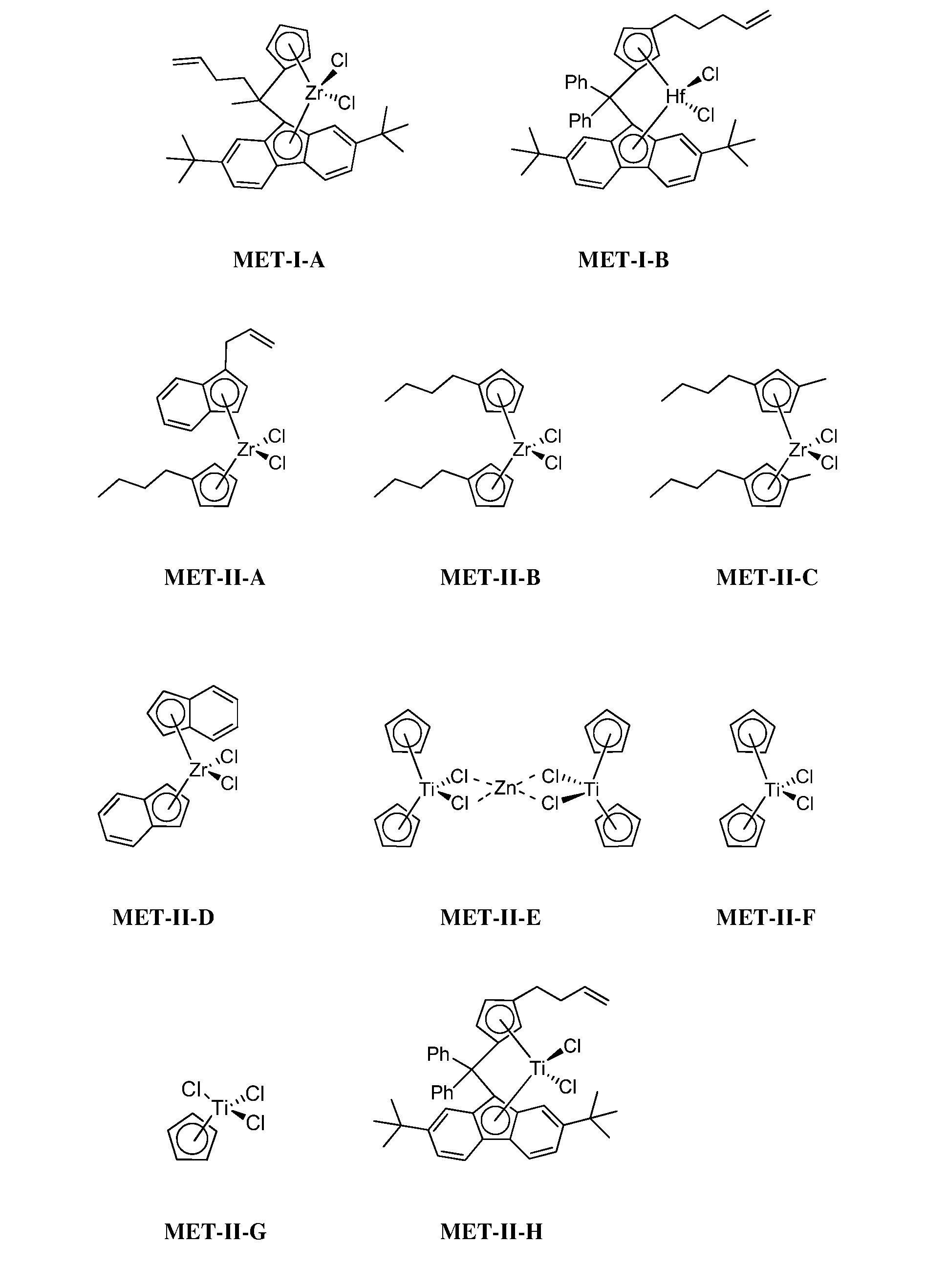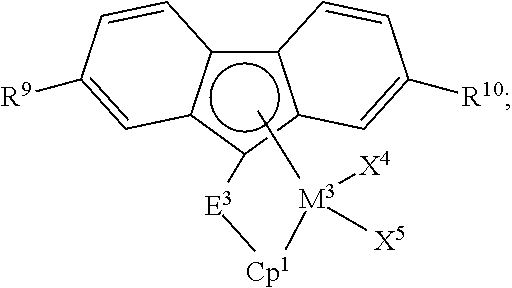Use of hydrogen scavenging catalysts to control polymer molecular weight and hydrogen levels in a polymerization reactor
a technology of hydrogen scavenging and polymerization reactor, which is applied in the field of olefin polymerization catalysis, metallocene catalyst composition, polyolefin polymerization, etc., can solve the problems of difficult to produce polyolefins with either a high molecular weight or a low melt index, and achieves lower melt indices, high molecular weight, and high unsaturation.
- Summary
- Abstract
- Description
- Claims
- Application Information
AI Technical Summary
Benefits of technology
Problems solved by technology
Method used
Image
Examples
examples
[0270]The invention is further illustrated by the following examples, which are not to be construed in any way as imposing limitations to the scope of this invention. Various other aspects, embodiments, modifications, and equivalents thereof which, after reading the description herein, may suggest themselves to one of ordinary skill in the art without departing from the spirit of the present invention or the scope of the appended claims.
[0271]Melt index (MI, g / 10 min) was determined in accordance with ASTM D1238 at 190° C. with a 2,160 gram weight.
[0272]High load melt index (HLMI, g / 10 min) was determined in accordance with ASTM D1238 at 190° C. with a 21,600 gram weight.
[0273]Polymer density was determined in grams per cubic centimeter (g / cc) on a compression molded sample, cooled at about 15° C. per hour, and conditioned for about 40 hours at room temperature in accordance with ASTM D1505 and ASTM D1928, procedure C.
[0274]Molecular weights and molecular weight distributions were o...
examples 1-2
Hydrogen Generated by Ethylene Feedstock and Sulfated Alumina and TIBA
[0277]The conditions employed were a reaction temperature of 95° C., 340 psig ethylene feed, 2 L of isobutane, 100 mg sulfated alumina, 0.5-1.0 mg of the metallocene, and 0.5 mL of 1 M TIBA. Calculations based on these conditions led to an estimated initial vapor volume of 1.27 L and a liquid volume of 2.5 L (for the 1-gallon reaction vessel). Using this information, the reactor vapor sample, and a calibrated micro-GC capable of detecting small levels of hydrogen in the vapor space of the reactor, the mole ppm level of hydrogen in the reactor can be determined.
[0278]In Example 1, no metallocene, sulfated alumina, or TIBA was charged to the reactor. The amount of hydrogen observed in the vapor phase sample was analyzed to be about 6 ppm at the 340 psig pressure.
[0279]In Example 2, no metallocene was charged to the reactor. The amount of hydrogen due to sulfated alumina and TIBA was determined to be about 13 ppm.
examples 3-9
Hydrogen Generated by MET-I-A and Dinuclear DMET-I-A in Olefin Polymerization
[0280]Under the conditions of Example 1, the polymerizations of Examples 3-9 utilized either 0.5 mg of MET-I-A or 1 mg of DMET-I-A, and the reaction times and amount of 1-hexene comonomer listed in Table I. Dinuclear DMET-I-A, a homodinuclear compound derived from MET-I-A, can be prepared in accordance with the procedure described in U.S. Patent Publication No. 2009-0170690, which is incorporated herein by reference in its entirety.
[0281]In these Examples, hydrogen was generated even with no 1-hexene comonomer present, but higher levels of hydrogen were generated when the comonomer was present, and when reaction time was increased. Under comparable conditions, there was less hydrogen generation with DMET-I-A than with MET-I-A.
[0282]
TABLE IHydrogen generation of Examples 3-9.Reaction1-hexeneHydrogenExampleCatalystTime (min)(g)(ppm)3MET-I-A6002134MET-I-A6052875MET-I-A12002976MET-I-A14053707DMET-I-A600308DMET-...
PUM
| Property | Measurement | Unit |
|---|---|---|
| melt index | aaaaa | aaaaa |
| density | aaaaa | aaaaa |
| temperature | aaaaa | aaaaa |
Abstract
Description
Claims
Application Information
 Login to View More
Login to View More - R&D
- Intellectual Property
- Life Sciences
- Materials
- Tech Scout
- Unparalleled Data Quality
- Higher Quality Content
- 60% Fewer Hallucinations
Browse by: Latest US Patents, China's latest patents, Technical Efficacy Thesaurus, Application Domain, Technology Topic, Popular Technical Reports.
© 2025 PatSnap. All rights reserved.Legal|Privacy policy|Modern Slavery Act Transparency Statement|Sitemap|About US| Contact US: help@patsnap.com



